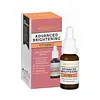What's inside
What's inside
 Key Ingredients
Key Ingredients

 Benefits
Benefits

 Concerns
Concerns

No concerns
 Ingredients Side-by-side
Ingredients Side-by-side

Water
Skin ConditioningAscorbyl Tetraisopalmitate
AntioxidantSqualane
EmollientCoco-Caprylate
EmollientDimethyl Isosorbide
SolventGlycerin
HumectantBetaine
HumectantSimmondsia Chinensis Seed Oil
EmollientPotassium Cetyl Phosphate
EmulsifyingTocopherol
AntioxidantHelianthus Annuus Seed Oil
EmollientRosa Canina Fruit Oil
EmollientXanthan Gum
EmulsifyingCetearyl Alcohol
EmollientSodium Phytate
Potassium Sorbate
PreservativeBenzyl Alcohol
PerfumingGlyceryl Laurate
EmollientCitric Acid
BufferingSodium Citrate
BufferingHydroxyethyl Acrylate/Sodium Acryloyldimethyl Taurate Copolymer
Emulsion StabilisingParfum
MaskingWater, Ascorbyl Tetraisopalmitate, Squalane, Coco-Caprylate, Dimethyl Isosorbide, Glycerin, Betaine, Simmondsia Chinensis Seed Oil, Potassium Cetyl Phosphate, Tocopherol, Helianthus Annuus Seed Oil, Rosa Canina Fruit Oil, Xanthan Gum, Cetearyl Alcohol, Sodium Phytate, Potassium Sorbate, Benzyl Alcohol, Glyceryl Laurate, Citric Acid, Sodium Citrate, Hydroxyethyl Acrylate/Sodium Acryloyldimethyl Taurate Copolymer, Parfum
 Reviews
Reviews

Ingredients Explained
These ingredients are found in both products.
Ingredients higher up in an ingredient list are typically present in a larger amount.
Betaine is a common humectant (a substance that promotes retention of moisture). It's known to be gentle on the skin and can help balance hydration.
This ingredient is best for improving hydration and soothing irritated skin. Studies also show it helps even out skin tone.
Fun fact: Betaine is naturally created in the skin and body. The kind found within cosmetic products can be either plant-derived or synthetic.
Another name for betaine is trimethylglycine.
Learn more about Betaine